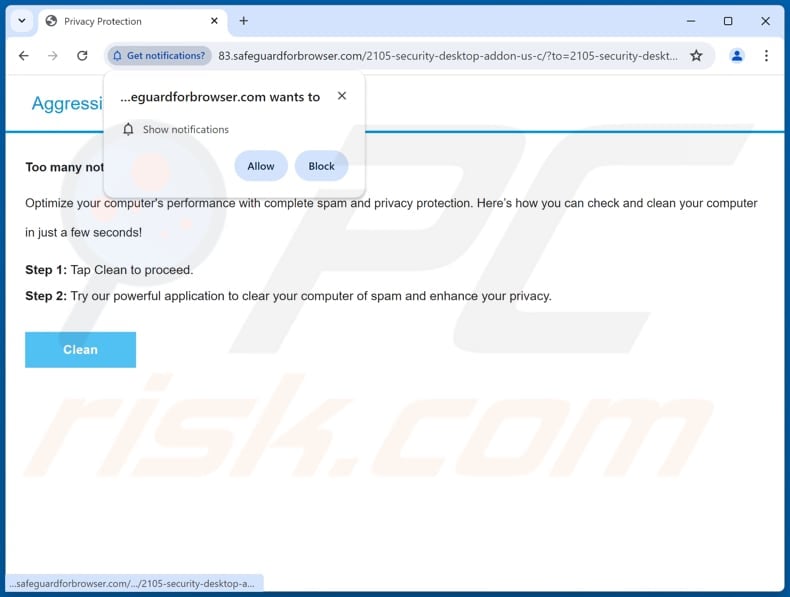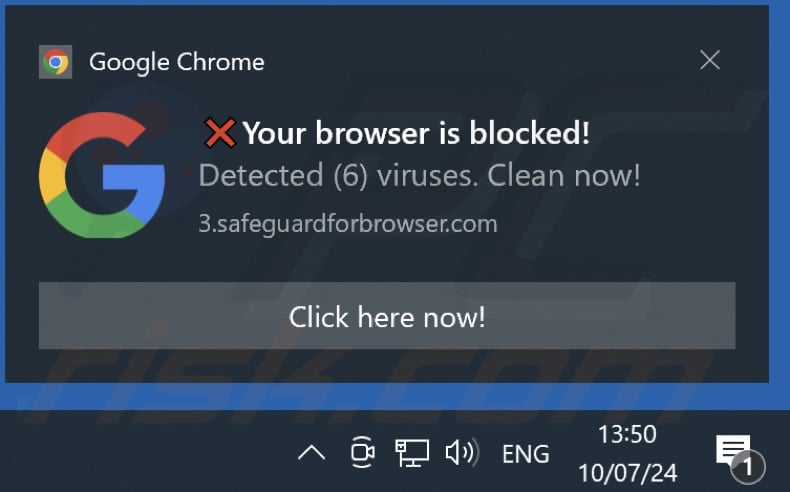How to stop receiving notifications from safeguardforbrowser.com
Notification SpamAlso Known As: Ads by safeguardforbrowser.com
Get free scan and check if your device is infected.
Remove it nowTo use full-featured product, you have to purchase a license for Combo Cleaner. Seven days free trial available. Combo Cleaner is owned and operated by RCS LT, the parent company of PCRisk.com.
What kind of page is safeguardforbrowser[.]com?
Our team has analyzed safeguardforbrowser[.]com and found that this page uses fear tactics and clickbait to trick visitors into taking certain actions. Typically, websites like safeguardforbrowser[.]com are accessed unintentionally. It is highly recommended that users close such sites if they encounter them.
![safeguardforbrowser[.]com ads](/images/stories/screenshots202407/safeguardforbrowser-com-ads-main.jpg)
Safeguardforbrowser[.]com in detail
Safeguardforbrowser[.]com has at least two different designs. In one case, safeguardforbrowser[.]com displays a fake pop-up warning claiming that the visitor's device has been compromised and urging them to take immediate action. Also, safeguardforbrowser[.]com claims that a user's Chrome browser is damaged by malware and aggressive ads have infiltrated the device.
It also instructs visitors to click the "Allow error alerts" button supposedly to subscribe to spam protection. However, clicking the "Allow" button grants safeguardforbrowser[.]com permission to send notifications. In the second scenario, safeguardforbrowser[.]com offers to optimize the computer's performance with complete spam and privacy protection.
In both cases, safeguardforbrowser[.]com asks for permission to show notifications. We discovered that notifications from safeguardforbrowser[.]com can contain fake alerts (e.g., messages claiming that the user's browser is blocked and six viruses have been detected). Interacting with these notifications can lead to untrustworthy websites.
Notifications generated by safeguardforbrowser[.]com can lead to phishing websites, fake lotteries, technical support scams, bogus giveaways, pages offering or urging to download potentially malicious apps, etc. Thus, trusting pages opened via notifications delivered by safeguardforbrowser[.]com might cause financial losses, identity theft, computer infections, and other problems.
Overall, it is strongly recommended not to visit sites like safeguardforbrowser[.]com and never allow them to show notifications. If such permission is already granted, it should be removed as soon as possible.
| Name | Ads by safeguardforbrowser.com |
| Threat Type | Push notifications ads, Unwanted ads, Pop-up ads |
| Detection Names | Fortinet (Phishing), Kaspersky (Phishing), Sophos (Phishing), Trustwave (Phishing), Full List Of Detections (VirusTotal) |
| Serving IP Address | 23.106.127.219 |
| Symptoms | Seeing advertisements not originating from the sites you are browsing. Intrusive pop-up ads. Decreased Internet browsing speed. |
| Distribution Methods | Deceptive pop-up ads, false claims within visited websites, unwanted applications (adware) |
| Damage | Decreased computer performance, browser tracking - privacy issues, possible additional malware infections. |
| Malware Removal (Windows) |
To eliminate possible malware infections, scan your computer with legitimate antivirus software. Our security researchers recommend using Combo Cleaner. Download Combo CleanerTo use full-featured product, you have to purchase a license for Combo Cleaner. 7 days free trial available. Combo Cleaner is owned and operated by RCS LT, the parent company of PCRisk.com. |
More anout similar pages
Users often find themselves on sites like safeguardforbrowser[.]com by visiting sites that utilize rogue advertising networks, such as torrent sites, illegal movie streaming pages, and similar platforms. They can also encounter such sites through misleading ads, pop-ups, or links on dubious websites. Additionally, ads from adware and links in deceptive emails can direct users to sites like safeguardforbrowser[.]com.
Some examples of similar web pages are kuartical[.]com, nomarmaconded[.]com, and theasitive[.]com.
How did safeguardforbrowser[.]com gain permission to deliver spam notifications?
When users visit pages that request permission to display notifications, they are usually presented with the option to "Allow" or "Block". Selecting "Allow" permits pages to send notifications. Consequently, safeguardforbrowser[.]com can send notifications because you have given it this permission.
How to prevent deceptive sites from delivering spam notifications?
If you come across a suspicious site requesting permission to show notifications, click "Block" (or the equivalent option) and close the page. It's important to note that legitimate websites typically do not require users to click "Allow" to confirm your age, watch video, complete a CAPTCHA, download files, etc.
If you are receiving unwanted notifications, we recommend running a scan with Combo Cleaner Antivirus for Windows to automatically eliminate them.
Appearance of safeguardforbrowser[.]com website (GIF):
![safeguardforbrowser[.]com website appearance (GIF)](/images/stories/screenshots202407/safeguardforbrowser-com-ads-appearance.gif)
Another appearance:

Deceptive notification from safeguardforbrowser[.]com:

Instant automatic malware removal:
Manual threat removal might be a lengthy and complicated process that requires advanced IT skills. Combo Cleaner is a professional automatic malware removal tool that is recommended to get rid of malware. Download it by clicking the button below:
DOWNLOAD Combo CleanerBy downloading any software listed on this website you agree to our Privacy Policy and Terms of Use. To use full-featured product, you have to purchase a license for Combo Cleaner. 7 days free trial available. Combo Cleaner is owned and operated by RCS LT, the parent company of PCRisk.com.
Quick menu:
- What is Ads by safeguardforbrowser.com?
- STEP 1. Remove spam notifications from Google Chrome
- STEP 2. Remove spam notifications from Google Chrome (Android)
- STEP 3. Remove spam notifications from Mozilla Firefox
- STEP 4. Remove spam notifications from Microsoft Edge
- STEP 5. Remove spam notifications from Safari (macOS)
Disable unwanted browser notifications:
Video showing how to disable web browser notifications:
 Remove spam notifications from Google Chrome:
Remove spam notifications from Google Chrome:
Click the Menu button (three dots) on the right upper corner of the screen and select "Settings". In the opened window select "Privacy and security", then click on "Site Settings" and choose "Notifications".

In the "Allowed to send notifications" list search for websites that you want to stop receiving notifications from. Click on the three dots icon near the website URL and click "Block" or "Remove" (if you click "Remove" and visit the malicious site once more, it will ask to enable notifications again).

 Remove spam notifications from Google Chrome (Android):
Remove spam notifications from Google Chrome (Android):
Tap the Menu button (three dots) on the right upper corner of the screen and select "Settings". Scroll down, tap on "Site settings" and then "Notifications".

In the opened window, locate all suspicious URLs and tap on them one-by-one. Once the pop-up shows up, select either "Block" or "Remove" (if you tap "Remove" and visit the malicious site once more, it will ask to enable notifications again).

 Remove spam notifications from Mozilla Firefox:
Remove spam notifications from Mozilla Firefox:
Click the Menu button (three bars) on the right upper corner of the screen. Select "Settings" and click on "Privacy & Security" in the toolbar on the left hand side of the screen. Scroll down to the "Permissions" section and click the "Settings" button next to "Notifications".

In the opened window, locate all suspicious URLs and block them using the drop-down menu or either remove them by clicking "Remove Website" at the bottom of the window (if you click "Remove Website" and visit the malicious site once more, it will ask to enable notifications again).

 Remove spam notifications from Microsoft Edge:
Remove spam notifications from Microsoft Edge:
Click the menu button (three dots) on the right upper corner of the Edge window and select "Settings". Click on "Cookies and site permissions" in the toolbar on the left hand side of the screen and select "Notifications".

Click three dots on the right hand side of each suspicious URL under "Allow" section and click "Block" or "Remove" (if you click "Remove" and visit the malicious site once more, it will ask to enable notifications again).

 Remove spam notifications from Safari (macOS):
Remove spam notifications from Safari (macOS):
Click "Safari" button on the left upper corner of the screen and select "Preferences...". Select the "Websites" tab and then select "Notifications" section on the left pane.

Check for suspicious URLs and apply the "Deny" option using the drop-down menu or either remove them by clicking "Remove" at the bottom of the window (if you click "Remove" and visit the malicious site once more, it will ask to enable notifications again)

How to avoid browser notification spam?
Internet users should be very skeptical when being asked to allow notifications. While this is a useful feature that allows you to receive timely news from websites you like, deceptive marketers frequently abuse it.
Only allow notifications from websites that you fully trust. For added security - use an anti-malware application with a real-time web browsing monitor to block shady websites that tries to trick you into allowing spam notifications. We recommend using Combo Cleaner Antivirus for Windows.
Frequently Asked Questions (FAQ)
Why am I seeing ads (browser notifications) delivered by safeguardforbrowser[.]com in the right lower corner of my desktop?
You have likely already visited safeguardforbrowser[.]com and allowed it to send notifications. No website can show notifications without permission from users.
I have clicked on notification ads, is my computer infected?
No, a computer cannot be infected by a notification. Nevertheless, interactions with notifications from untrustworthy pages can direct to potentially malicious sites.
Is safeguardforbrowser[.]com a virus?
Websites like safeguardforbrowser[.]com are not viruses. Typically, they display deceptive content and promote other dubious websites, potentially malicious programs, various scams, etc.
Will Combo Cleaner remove safeguardforbrowser[.]com ads automatically or manual steps are still required?
Yes, Combo Cleaner will scan your computer and remove all the permissions granted to safeguardforbrowser[.]com. It will also block further access to safeguardforbrowser[.]com. No additional steps will be needed.
Share:

Tomas Meskauskas
Expert security researcher, professional malware analyst
I am passionate about computer security and technology. I have an experience of over 10 years working in various companies related to computer technical issue solving and Internet security. I have been working as an author and editor for pcrisk.com since 2010. Follow me on Twitter and LinkedIn to stay informed about the latest online security threats.
PCrisk security portal is brought by a company RCS LT.
Joined forces of security researchers help educate computer users about the latest online security threats. More information about the company RCS LT.
Our malware removal guides are free. However, if you want to support us you can send us a donation.
DonatePCrisk security portal is brought by a company RCS LT.
Joined forces of security researchers help educate computer users about the latest online security threats. More information about the company RCS LT.
Our malware removal guides are free. However, if you want to support us you can send us a donation.
Donate
▼ Show Discussion